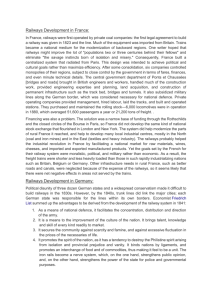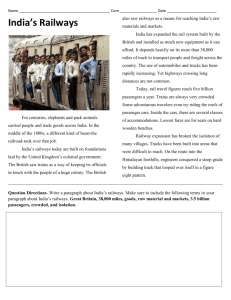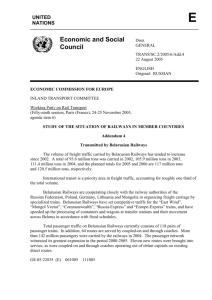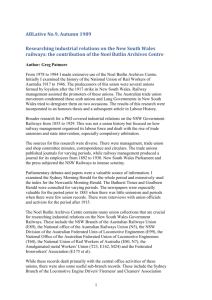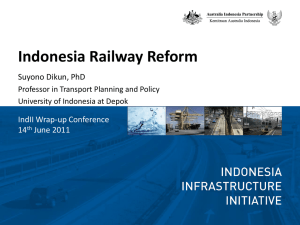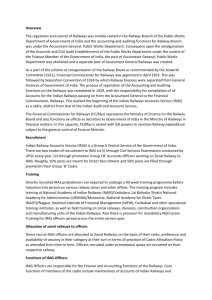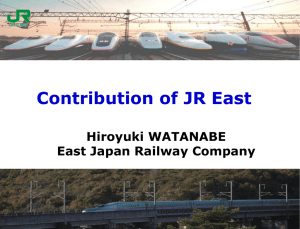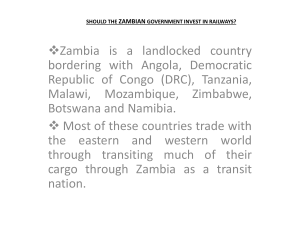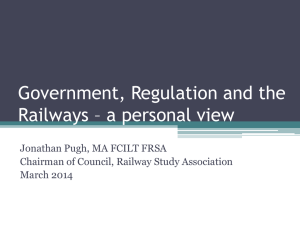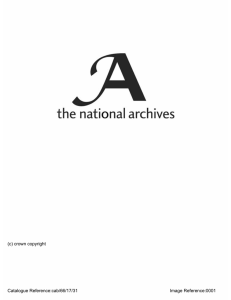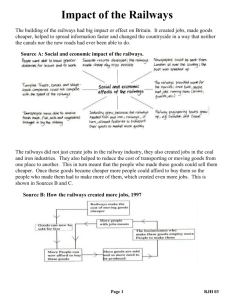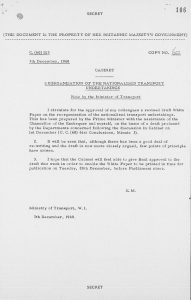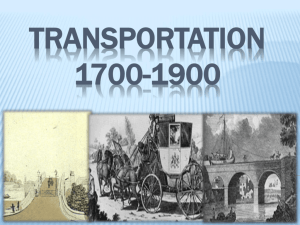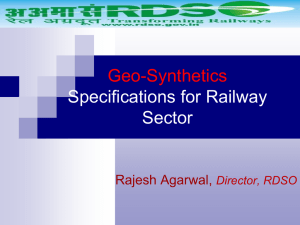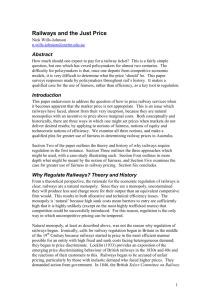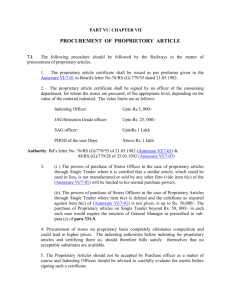Railways and the Raj: The impact of colonial infrastructure
advertisement
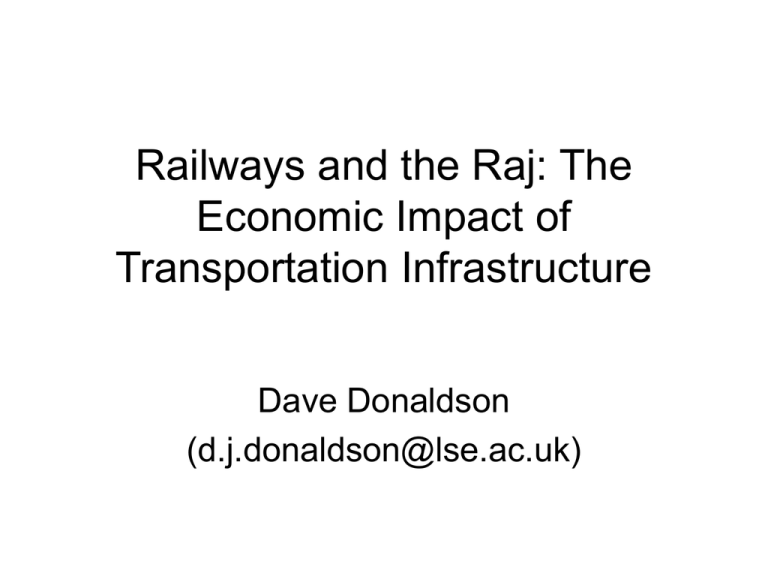
Railways and the Raj: The Economic Impact of Transportation Infrastructure Dave Donaldson (d.j.donaldson@lse.ac.uk) Research Questions • What is the effect on economic outcomes of opening up to external (ie. international) trade? • What is the effect on economic outcomes of enabling internal (ie. inter-regional) trade? • What are the economic gains from improving transportation infrastructure? • Why economic change underpins these effects? Motivation • Our understanding of the effects of openness to trade is still incomplete: – External trade: usually all of country liberalises trade at same time, so finding counterfactuals is difficult – Internal trade: virtually unexplored, for lack of data • Transportation infrastructure is a dominant important policy issue in LDCs (eg WDR 1994), yet evidence base is lacking – very hard to evaluate, due to endogenous placement This paper • Collect new dataset on prices, wages, production (agricultural), and trade at the district-level (N=~300) in India, from 1870-1925 • Use features of colonial construction of railways (18501900) in India as a set of ‘natural experiments’ in openness – Military motive (responding to domestic and foreign aggression) – Famine-prevention motive • Study impact of railways on agricultural output • Interpret this impact in context of a simple trade model – Predicts specialisation in comparative advantage crops • Use data on internal and external trade flows to examine this mechanism • Where data permits, examine other possible mechanisms (capital and labour reallocations, technological change) Why Colonial India? • This region and period of history offer a number of institutional and methodological advantages: – Railway system was dramatic shock (in most of India at this time, road and river transport was poor/nonexistent) – Railway line placement motives were non-economic in many instances – Availability of unique internal trade data • Allows external trade to be studied using within-country variation • Allows internal trade to be studied Related Literature • Effect of openness, using natural experiment approach: – Bernhofen-Brown (JPE ‘03, AER ‘04) use Japan’s 1851 (forced) openness to test comparative advantage mechanisms behind opening – Michaels (2006) uses US Interstate highway expansion to study effect of openness on skill premium • Quantifying the gains from railways: – Fogel (1967) on USA: uses ‘social savings’ technique, ignores endogenous placement – Hurd (1998) on India: same method; finds large effect (9% of GDP in 1900) This presentation – Background: • Railways • Economic environment – Elements of a simple theoretical framework for thinking about these issues – Data – Empirical method • Identification strategy for estimating effect of railways • What economic mechanisms underpin this effect? Background: Railways • Principal public investment in colonial India (over half of government spending) • Mixtures of pure public and public-private provision, but Indian Government always determined route selection • 95% of current lines built in 1853-1930 • 1870-1920 was highest growth period 1870 65 districts had railway somewhere in district 1900 170 districts had railway somewhere in district 1930 220 districts had railway somewhere in district Background: Economic Environment (1) • Structure of economy in 1870: – Agriculture: 68% of GDP, (73% of labour) – Small-scale manuf. and services: 26%, (26%) – Large-scale manufacturing: 0.5%, (0.2%) • Structure of economy in 1930: – Agriculture: 59%, (75%) – Small-scale manuf. and services: 34%, (23%) – Large-scale manufacturing: 4%, (2%) Background: Economic Environment (2) • Effect of railways on transport costs: – Standard estimates suggest that the pure freight costs of railways were 5-10 times lower than on alternative method (bullock carts) – However, this ignores other savings: • Bullocks/roads seasonal (bullocks need food/water, roads unpassable for Data (1870-1930) • Agricultural production (annual, ~300 districts/native states): – – – – Yields, by crop (~15 crops) Land area allocations, by crop Capital stocks (livestock, carts) Irrigated areas, by crop • Prices and wages (annual, ~200 districts/native states) – Prices: by ~30 commodities – Wages: by ~5 occupations (skilled and unskilled) • Trade (annual, ~70 trade blocks): – Internal trade: full block-to-block matrix of trade flows (but intrablock diagonals empty) – External trade: trade by port, by foreign country – All in physical units, by commodity (~100 goods), by mode of transportation (rail, river, coast) Limitations of the Data • Agricultural Yields: – Subject of much controversy among econ historians – Created by multiplying normal yields (factual) by subjective ‘conditioning factor’ – But largely corroborated by quinquennial crop-cutting surveys (and no obvious signs that this is not just classical ME) • Trade data: – External trade flows by block not collected • have to make assumptions of constant port consumption, and no port transformation – Roads data very limited in coverage – Lack of unit values may obscure quality-differentiation within observed commodity classifications The second stage • Run regressions of form: ydt d t Rdt X dt dt y = real agricultural output d = district t = year R = shortest distance from (populationweighted geographic) centre of district to railway X= other controls • Can then think of modifying how R is included, to allow for heterogeneous treatment – Distance to port (and which port) – Distance to internal cities, or other markets The first stage •Run regressions of form: Rdt d t Zdt X dt dt •Where Z is a variable that predicts R, but has no direct effect on y General IV set-up (1) • Railways are lines designed to connect two points, A and B • For any points (A,B), and the observed railway between them, can ask: – What is the effect of the railway on A or B? – What is the effect of the railway on intervening point C? C RCdt = d d A B RAdt ~=0 RBdt ~=0 General IV set-up (2) • Challenge is to find A-B pairs, such that: – (1) the decision to put a railway between A and B had nothing to do with unobservable characteristics of C – (2) there is nothing unobservably different about locations C along the line from A-B • It is very unlikely that A or B can be used in the analysis, for fear that exclusion restriction violated there – So ideally want 2 or more IVs, with very different types of A-B pairs Instrumental Variables (Option 1): Famine-prevention in 1880 • 1880 Famine Commission recommended a number of railways to be built • This was idiosyncratic feature of that Commission: earlier and later Famine Commissions did not recommend any railways • Translation into instrument – A: locations of abnormally low rainfall in 1877-78 – B: nearest point to A that is on an 1879 railway line – Control for rainfall variation (at C) throughout period Lines suggested in 1880 Famine Commission report Instrumental Variables (Option 2) – Military Transportation • Macpherson (1955) estimates that over half of track placement decisions were militarily-driven • British government was motivated by internal control, and external border defence (esp. Afghanistan border) • Translation to IV: – A: sites of suspected military action, not already on a railway at time t – B: nearest military cantonment (base) to A, or nearest point on existing railways to A What mechanisms drive the result? • Obtain a 2SLS estimate ˆ, but what is driving this change? – Specialisation? – Specialisation according to comparative advantage? – Capital accumulation: • returns to capital higher? • railways affected banks’ ability to monitor borrowers? – Labour supplied to agriculture changes? • Higher wage draws in labour from other sectors? • Railways enable migration? – Land used in agriculture increases? • Extension of land cultivation margin (deforestation etc.)? • More double-cropping? – Technological progress? • Returns to innovation higher (size of market larger)? • Technology transfer on the railways? Conclusion • Have presented plans for future research designed to help address important gaps in our understanding of external and internal openness – What is the effect of openness? – What is driving this effect?


